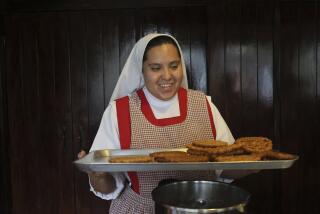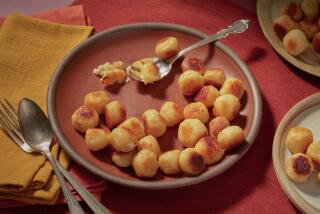Too Many Cooks May Spoil Taste of Gingerbread
- Share via
NUREMBERG, Germany — It’s been used by folklore’s witch to imprison Hansel and Gretel, by architects to describe the fancy edging under their gabled eaves and by revelers through the ages to decorate trees and tables for the Christmas season.
But the inspiration more than 600 years ago for the most famous product of this medieval crossroads--gingerbread--is known to few consumers in its native country. Gingerbread was the original power bar--a durable high-protein and vitamin-rich confection intended to nourish the wealthy through winter.
Today, though, the once-revered delicacy has become a riches-to-rags story. Although the local bakers guild still holds a patent on what can be labeled original Nuremberg gingerbread, or lebkuchen, the local specialty brought to international fame by the Brothers Grimm and mail-order marketing is being edged out by cheap imitations.
Sales of Nuremberg-made cakes have been static over the past decade even as national and regional consumption has been rising, meaning that people are eating more of the cheap stuff.
Every supermarket and department store is chockablock with rogue lebkuchen this time of year--much of it mass-produced at factories in other parts of Germany and in northern and eastern Europe.
“There is a risk of these outside producers ruining the whole industry by using low-quality ingredients and packaging the cakes so that they go stale before anyone eats them,” says Rainer Schmucker, production chief for the E. Otto Schmidt company, which sells 150 million gingerbread cakes each season. “All we can do is to keep making our cakes according to the registered standards. We, too, now produce large quantities, but we still guarantee quality.”
Unlike the other two main producers, Weiss and Schumann, Schmidt tries to maintain exclusivity by selling its wares only in company-owned stores and through mail-order catalogs. But holiday promotions, like a deal this month from an office discount retailer for a Nuremberg lebkuchen with every cartridge of printer ink sold, tend to relegate what was once a luxury to the lowly status of the ubiquitous Christmas fruitcake.
The deep brown rounds and oblongs tumble out of ovens here at the rate of 6 million a day this time of year, traveling along miles of conveyor belts to be cooled, glazed, sealed in cellophane and packed into collectors tins.
Each year, more than 200 million pounds are sold in Germany alone, to the tune of $300 million; producers in Scandinavia and the Baltic states also compete for sales around the world. Even Weiss recently bankrolled a factory in Poland to produce a more affordable variety for the global market, says Britta Bungartz of the Federal Assn. of Confectionery Industries. Sweden’s retailing giant, IKEA, also has gotten into the mass-production act, selling at least 100,000 prefabricated gingerbread-house kits each season, says company spokeswoman Linda Tinnert.
Here in Germany’s fairy-tale heartland, however, tradition still holds sway. Bavarians, on average, will have eaten nearly 60 pieces of gingerbread each by the end of the holiday season, compared with the national average of 18, Bungartz says.
Locals also contend that they never get sick of the aroma that wafts across the suburbs night and day.
“The baking starts in late August, and from then on much of the city is pungent with cinnamon and other spice aromas,” says Gesa Buechert, lebkuchen historian at the Museum of Industrial Culture. “Some people say they stop noticing it, but no one ever says they don’t like it.”
Gingerbread made its appearance in the annals of city history in 1395, Buechert says. Nuremberg during the Middle Ages was a thriving river trade post where caravans stopped to peddle their precious Far Eastern wares. Among other things, they brought the ginger, cardamom, dried citrus and a dozen other aromatic herbs and spices that transformed local varieties of cakes.
Despite the shift from family to factory production, the local guardians of the gingerbread legacy insist that they will never bow to the busy modern homemaker by concocting a prepared mix for gingerbread.
“There is no demand for that here,” says Bungartz, appalled at the very notion. “We are a very tradition-bound society, and people either buy high-quality gingerbread for their holidays or they bake it themselves from old family recipes.”
More to Read
Eat your way across L.A.
Get our weekly Tasting Notes newsletter for reviews, news and more.
You may occasionally receive promotional content from the Los Angeles Times.











